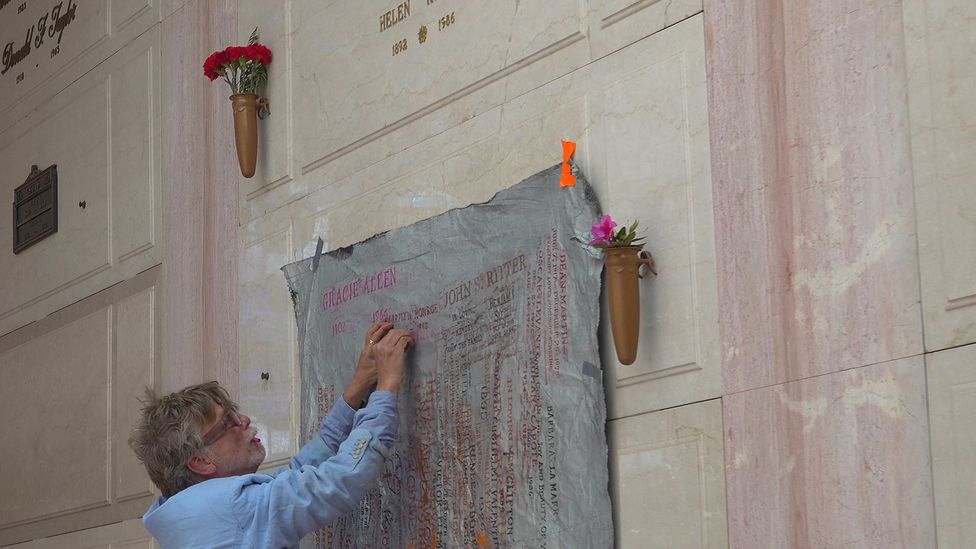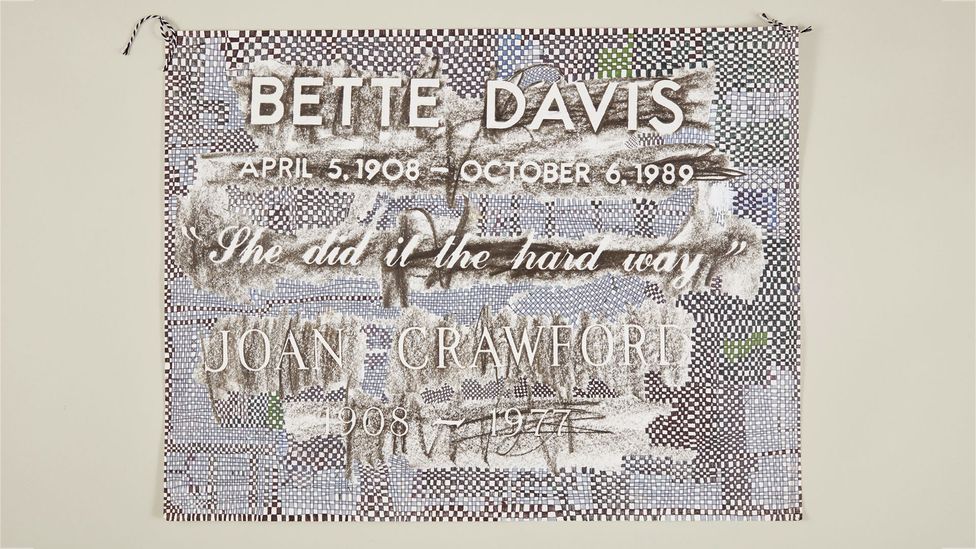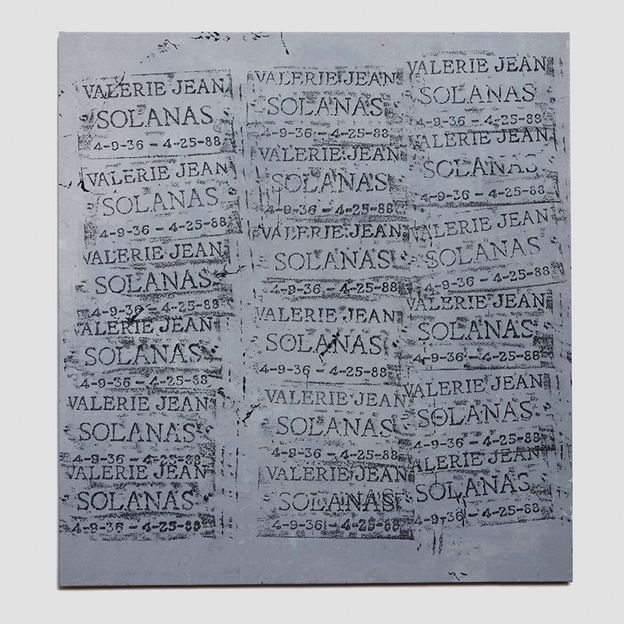What's in a name? Juliet may have thought that a rose might smell as sweet regardless of what it was called, but in Scott Covert's line of work the name is everything. For decades the American artist has been travelling across the world collecting them. Frank Sinatra. Marilyn Monroe. Andrew Cunanan. Valerie Solanas. Sammy Davis Jr. Judy Garland. Candy Darling. The Shah of Iran. Edith Bouvier Beale. Stars, cult figures, leaders, murderers, the occasional friend: Covert goes for those whose name now stands for something, whether that "thing" is talent, tragedy or infamy. Covert's methods of acquisition are unconventional and intimate, as well as extremely tactile. He takes rubbings from their gravestones.
More like this:
– How old clothes can haunt us
– The film and TV facing up to death
These rubbings form the basis of his Monuments paintings: dense, often vast works, where colour vies with text. In some, the names jumble and blur, with what feels like hundreds of people sharing the same canvas, like a plot of land. In others, they are brought into sharp relief, Charlton Heston, Humphrey Bogart and Groucho Marx distinct but nestled close. It might take years for a piece to be completed, waiting for just the right juxtaposition of names. This could involve sworn enemies (Bette Davis and Joan Crawford), unlikely alliances (Amy Winehouse and William Blake) or startling contrasts (he is working on a piece that combines the cast of the Wizard of Oz with the victims of the Manson murders, because "that's very LA".) Dates and epitaphs also feature and intertwine. "Queen of the Pin-Ups." "Actor, Writer and Superstar." "Beloved Mother." "With God, In the Joy of Beauty and Youth." "Everybody Loves Somebody Sometime."

Covert has said he simply wants to "make something beautiful" by taking impressions of famous people's gravestones (Credit: Scott Covert)
Covert's paintings are currently on show at London's Studio Voltaire gallery. C'est la Vie is his first solo exhibition outside of the US, but he's been doing this for nearly 40 years. He made his first grave rubbing in 1985, when in his early thirties: The Dead Supreme, paying homage to founding Supremes member Florence Ballard, who died in 1976 aged only 32. "I was always a Supremes person," he explains to BBC Culture over the phone from New York. "You know, I make this joke. I'm friends with Theodora Richards, Keith Richards' daughter, and she asked me, 'who did you prefer: the Rolling Stones or The Beatles?' And I said, 'the Supremes'." He wasn't sure what exactly he was doing when he first visited Ballard's grave in Detroit Memorial Park Cemetery but he knew he wanted to make a rubbing. "When I did it, [the canvas] slipped. So I did it again, with a different colour. And that's when the bell rang." Afterwards, he showed it to his friend, the actor and writer Cookie Mueller, who suggested Covert drop his own attempts at acting, in which he had been trying to forge a career, and focus on his art.
His renegade adventures
Since then, Covert has travelled all over the world in search of people's final resting places. From LA to Moscow, Egypt to England, he has pursued the great, the good, the sad and the ugly. It's a simple process. He picks a name – or rather, becomes "possessed" by one. He packs a car or suitcase with muslin, paper, charcoal, oil sticks, and paint. Perhaps some in-progress canvases too. "I'm wondering what the hell am I going to be doing with this?" he says. "And then I go on the road." The journey is a form of suspended anticipation. He's got to get there to see what will emerge – what kind of conversation he wants to create with this silent figure whose reputation has outlived their corporeal existence.
His own name is fitting, given that he's occasionally had to be rather sneaky in the process. He'll tell you stories about getting a friend to distract the security guard outside Elizabeth Taylor's grave or being kicked out of Edgwarebury Cemetery, where Amy Winehouse is buried. "I mean, I'm older now… But I've climbed over fences in the middle of the night with a flashlight," he chuckles. Regardless of advancing years, he remains dogged in his pursuit. The only thing that will stop him is a literal absence of a grave. "A lot of people are cremated and scattered," he sighs. "[That] pisses me off."
Covert's fascination with cemeteries stretches back to his youth. "I lived near a colonial cemetery in New Jersey, and we would go over there and [make rubbings], you know, with the skulls and stuff… in fourth and fifth grade," he explains. For him it wasn't just about the graves or what they represented, but the setting. He liked the solitude. "I'm a loner," he says cheerily. Today, he still works, largely, by himself, much of his time spent on freeways, in pursuit of far-flung cemeteries. He's currently planning a trip to the Cuban-American painter, sculptor and performance artist Ana Mendieta's grave in Cedar Memorial Park, Iowa. He might also stop in on American Gothic artist Grant Wood's grave, also in Iowa. If he's going through Detroit, he’ll swing by Aretha Franklin's. In Chicago, he can visit various blues players including Chester Burnett. After Mendieta; maybe he'll also head south to Kansas City for saxophonist Charlie Parker and temperance advocate Carrie Nation.

Covert often juxtaposes names in his pieces – such as here, arch Hollywood rivals Bette Davis and Joan Crawford (Credit: Scott Covert)
Pilgrimage often involves the creation of a personal map. Whether one is going in search of holy wells, cult film locations, rare birds, or feats of Victorian engineering, it provides a series of connecting threads that overlay the usual borders and terrains. One gets the sense that Covert's whole world is oriented by cemeteries – each a beacon, its potential depending on who is buried there. It's easier now in the days of Google Maps and online records, but graves used to be hard to locate. Covert tells me about how he met someone who became a dear friend graveside in Culver City, next to Rita Hayworth's resting place. Part of the so-called Hollywood Underground, a loose group devoted to finding the graves of those celebrities whose whereabouts have been kept under wraps, he was an invaluable source of information.
Although this might all sound rather macabre, there is a sprightly, curious quality to Covert's work and attitude: a sense of single-minded devotion and obsession. He has been described as Warholian in his approach to pop culture and celebrity, but there is something immensely sincere to these paintings. Some of them might be naughty and others dark (he says that the graves of Perry Smith and Richard Hickock, convicted of the murders of the Clutter family and the focus of Truman Capote's In Cold Blood, made him feel "repulsed"), but many are reverent – even loving. Covert says he developed his way of working because he wanted to make abstract paintings. A name is just another kind of mark – one in which "each brushstroke" holds a lifetime. It also becomes evidence of having been somewhere. The paintings themselves are maps. In being made, they prove that the maker travelled all that way, driving for 14 hours or getting on a plane, to get to that particular grave, and to the particular person it memorialises. It is, as another friend once pointed out to him, the opposite of graffiti. He does not leave his mark. Instead he diligently acquires it, amassing a series of numbers and letters summarising a whole history.
The power of the gravestone
In her book These Silent Mansions: A Lifetime in Graveyards, the poet Jean Sprackland writes about her own lack of interest in famous gravestones. Instead, she is drawn to "the unremarkable and forgotten, whose names can no longer be deciphered". She likes them, she says, because they remind her of "the span of human life – how one may be longer than another but all are finite – and how I and everyone around me is part of the inescapable repeating pattern so explicitly demonstrated here." There is something humbling in being in a graveyard, in being reminded of the fragility of life and the inevitability of death. Everything must come to an end, including us. British artist Nathan Coley's 2010 work In Memory featured a series of gravestones that had, for a variety of mysterious reasons, been removed from the place they were intended to stand. On each, the name was chiselled out: a blank square in its place, leaving behind only messages of rest and loving memory. In their anonymity, they became something that could belong to anyone's dear father or beloved wife. Unmoored from their specific commemorative function, they also morphed, according to the work's accompanying notes, back into objects: shapes hewn and carved from stone or granite, rather than reminders of someone specific, a whole life compressed between two dates.

Valerie Solanas, the woman who shot Andy Warhol, is one of the darker subjects featured (Credit: Collection of Matthew Higgs and Anne Collier)
Even if, like Sprackland, one prefers to wander in the realms of the ordinary dead, speculating about their lives (who was Manuel M De Morentin who died in 1895? What anguished grief lies behind the grave of Leander S. who lived for only a year?) or trying to make out ghostly, dissolving letters, a name does anchor us to the fact that there was once a person who possessed it. But with Covert's work, these are names that have undergone a symbolic alchemy, no longer just a name but something that invokes a finely spun web of associations, reputations, images, strong feelings, and collective memories. Does it belong to a comedian who made people weep with laughter, a musician who pioneered a new sound, a murderer whose trial was widely publicised, or an actress whose talent for playing the part of the "dumb blonde" was so great that people still mistake her for one today? Is it known only in the most devoted circles, now fading fast from the public consciousness?
Celebrity can be a fickle, glittering thing, beguiling in its promise of "making a name" of someone, merciless in the sacrifices it demands in exchange for the privilege of not being forgotten. But to be known and commemorated can also be a great gift – a form of immortality from beyond the grave, held in the love and admiration of others. If a gravestone is a promise to the dead that they did once exist, then it is also a landmark for the living, a place for grieving, recollection, one-sided conversations, singular pilgrimages, repeat visits. By Covert's own admission, he just wants to "make something beautiful." But in doing so, he raises complicated questions about how we remember the dead – these questions rising slowly to the surface, like a name appearing on a thin sheet of muslin held against a brass relief.
Scott Covert, C'est La Vie is at Studio Voltaire, London until 7 May
If you would like to comment on this story or anything else you have seen on BBC Culture, head over to our Facebook page or message us on Twitter.
And if you liked this story, sign up for the weekly bbc.com features newsletter, called The Essential List. A handpicked selection of stories from BBC Future, Culture, Worklife and Travel, delivered to your inbox every Friday.
"celebrities" - Google News
April 14, 2023 at 02:00PM
https://ift.tt/brNvThU
Scott Covert: Why one artist has made it his life's mission to hunt down dead celebrities - BBC
"celebrities" - Google News
https://ift.tt/ju9hSxK
https://ift.tt/JNI30DO
Bagikan Berita Ini














0 Response to "Scott Covert: Why one artist has made it his life's mission to hunt down dead celebrities - BBC"
Post a Comment